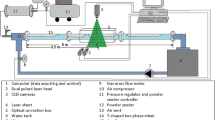Abstract
In this paper, the recirculation flow motion and turbulence characteristics of liquid flow driven by air bubble stream in a rectangular water tank are studied. The time-resolved Particle Image Velocimetry (PIV) technique is adopted for the quantitative visualization and analysis. 532nm Diode CW laser is used for illumination and orange fluorescent (λex = 540nm, λem = 584nm) particle images are acquired by a 1280×1024 high-speed camera. To obtain clean particle images, 545nm long pass optical filter and an image intensifier are employed and the flow rate of compressed air is 3ℓ/min at 0.5MPa. The recirculation and mixing flow field is further investigated by time-resolved Proper Orthogonal Decomposition (POD) analysis technique. It is observed that the large scale recirculation resulting from the interaction between rising bubble stream and side wall is the most dominant flow structure and there are small scale vortical structures moving along with the large scale recirculation flow. It is also verified that the sum of 20 modes of velocity field has about 67.4% of total turbulent energy.
Similar content being viewed by others
References
W. Luewisutthichat, A. Tsutsumi and K. Yoshida, Chaotic Hydrodynamics of Continuous Single-Bubble Flow Systems, Chemical Engineering Science, 52 (1997) 3685–3691.
P. Tirto, T. Koichi and T. Hideki, Effect of Operating Conditions on Two-Phase Bubble Formation Behavior at Single Nozzle Submerged in Water, Journal of Chemical Engineering, 34(2) (2001) 114–120.
X. Tu and C. Trägårdh, Methodology development for the analysis of velocity particle image velocimetry images of turbulent, bubbly gas-liquid flows, Measurement science & technology, 13(7) (2002) 1079–1086.
T. G. Theofanous and J. Sullivan, Turbulence in Two-phase Dispersed Flows, Journal of Fluid Mechanics, 116 (1982) 343–362.
S. K. Wang, S. J. Lee, O. C. Jones and R. T. Lahey, Turbulence Structure and Phase Distribution Measurements in Bubbly Two-phase Flows, International Journal of Multiphase Flow, 13 (1987) 327–343.
A. Fujiwara, D. Minato and K. Hishida, Effect of Bubble Diameter on Modification of Turbulence in an Upward Pipe Flow, International Journal of Heat and Fluid Flow, 25 (2004) 481–488.
F. Durst, A. M. K. P. Taylor and J. H. Whitelaw, Experimental 3and Numerical Investigation of Bubble-driven Laminar Flow in an Axisymmetric Vessel, International Journal of Multiphase Flow, 10 (1984) 557–569.
S. T. Johansen, D. G. C. Robertson, K. Woje and T. A. Engh, Fluid Dynamics in Bubble Stirred Ladles: Part I. Experiments, Metallurgical Transactions, 19B (1988) 745–754.
G. Montante, D. Horn and A. Paglianti. Gas-liquid flow and bubble size distribution in stirred tanks, Chemical engineering science, 63(8) (2008) 2107–2118.
L. Sirovich, Turbulence and The Dynamics of Coherent Structures PART I: Coherent Structures, Quarterly of Applied Mathematics, 45 (1987) 561–571.
K. C. Kim, Y. U. Min, S. J. Oh, N. H. An, B. Seoudi, H. H. Chun and I. Lee, Time-Resolved PIV Investigation on the Unsteadiness of a Low Reynolds Number Confined Impinging Jet, Journal of visualization, 10(4) (2007) 367–380.
Author information
Authors and Affiliations
Corresponding author
Additional information
This paper was recommended for publication in revised form by Associate Editor Kyung-Soo Yang
Hyun Dong Kim Ph.D. Candidate in the Department of Mechanical Engineering of Pusan National University He received the M.S. degree in Mechanical Engineering from Pusan National University in 2005. His main research interest is the development of fluid measurement techniques in the micro-scale such as micro-PIV, micro-LIF, and defocusing digital PTV. He is also interested in particle manipulation in a microchannel using a pneumatic micro-pump.
Seung Jae Yi, He received the B.S. degree in Mechanical Engineering from Pusan National University of Korea in 2007, and the M.S. degree in Mechanical Engineering from Pusan National University of Korea in 2009. His research interests are particle image velocimetry (PIV) measurement technology, characteristics of bio-fluids, and sensing chemistry using MEMS/NANO technology.
Jong Wook Kim, He received his B.S. (Eng) in Mechanical Engineering from KAIST (Korea Advanced Institute of Science and Technology), Korea in 1998, and his M.S degree in Mechanical Engineering from Hanyang University of Korea in 2000. He obtained his M.S degree with this paper’s theme, experiment and analysis of counter-rotating axial fan. His research interests are measurement of thermal properties of thin film in nano scale using 3 omega method and thermal reflectance, and characteristics of flow by using POD (Proper Orthogonal Decomposition).
Kyung Chun Kim, Professor in the School of Mechanical Engineering of Pusan National University and Director of the MEMS/NANO Fabrication Center in Korea. He obtained the Ph.D. degree from the Korea Advanced Institute of Science and Technology (KAIST), Korea, in 1987. He was selected as a Member of the National Academy of Engineering of Korea in 2004. Since 2008, he has served as President of the Korean Society of Visualization. His research interests include 3D3C Micro-PIV, Bio-MEMS, micro/nanoscale energy transport, turbulence measurements based on PIV/LIF, micro-heat exchangers, biomechanics, biomedical engineering, POCT development for early detection of OP, wind turbines, and fuel cells.
Rights and permissions
About this article
Cite this article
Kim, H.D., Yi, S.J., Kim, J.W. et al. Structure analysis of bubble driven flow by time-resolved PIV and POD techniques. J Mech Sci Technol 24, 977–982 (2010). https://doi.org/10.1007/s12206-010-0210-1
Received:
Revised:
Accepted:
Published:
Issue Date:
DOI: https://doi.org/10.1007/s12206-010-0210-1




